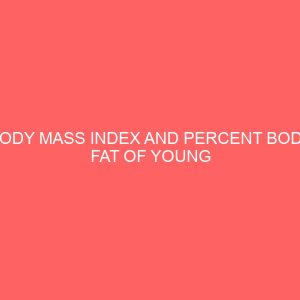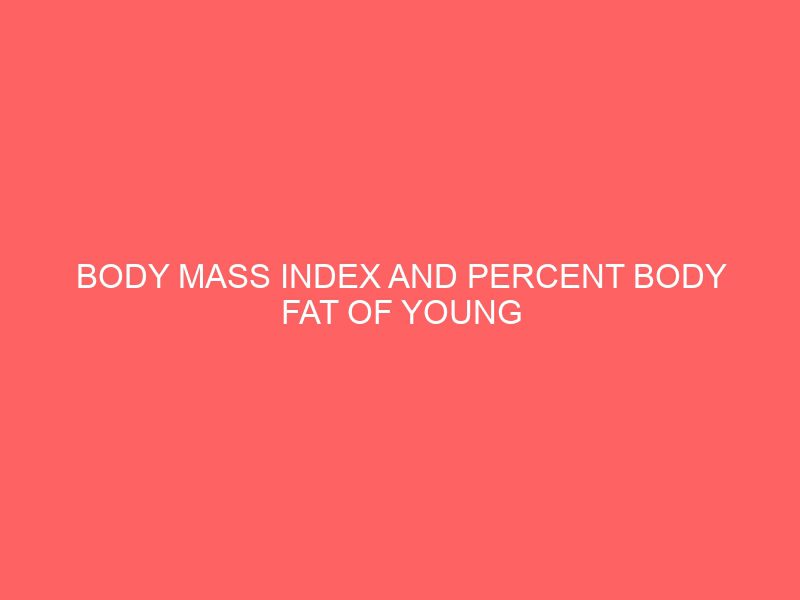Description
CHAPTER ONE
1.1 INTRODUCTION
In recent times, obesity seems to have reached epidemic proportions. Its astronomical increase has been a singular factor to the cause of many premature deaths in the society (Webb, 2002) mortality rate is in the increase and life expectancy reduced. It possess many health problems that in turn leads to death.
According to stage up America (2000), obesity is associated with five of the top leading causes of death and disability in U.S; heart disease, some form of cancer, type II diabetes, stroke and high blood pressure.
Similarly, Heyward (2002) stated that overweight and obesity increases ones risk of developing serious cardiovascular, pulmonary, metabolic diseases and disorders.
In the recent past, it was thought that Obesity is a disease associated to adults, leaving the young (children) out of it. In studies carried out by Guo et al. (1994) & Must et al (1992), it was reported that adolescent weight is a good predictor of adult Obesity, so also did Telama et al (1997) that active children became active adults. It can be inferred that lifestyle adopted when young, goes a long way in determining ones health status in adulthood.
According to life insurance studies, the health effects of obesity seems to be greater in males than in females because of the site of fat accumulation (abdominal area).
However pathetic, the high occurrence in male adolescents gives a startling statistics. In contrast to the past, the present occurrence surfaced as an aftermath of a sustained practice of an un-ideal health lifestyle such as poor eating habit coupled with sedentary living. The decline in physical activity is strongly implicated as an important cause of the rapid increase in overweight and obesity (Prentice & Jebb, 1995).
So also, does an uncontrollably eating habit (Schachter & Rodin, 1974) and automation contribute to obesity (Webb, 2002)
Furthermore, in a bid to correct this, some anthropometric indexes such as Body Mass Index (BMI) and Waist-to- hip ratio (WHR) have been developed to identify individuals at risk in order to promptly effect a redress before it worsens. Many individuals have displayed mixed reactions on the choice of assessment to be used in ascertaining obesity. It was argued that the waist-to-hip ratio seems to be best in determining the health risk associated with obesity because it estimates the fat at the abdominal region poised to be the most dangerous fat site in the human body as it is associated with a lot of disease (Hoeger & Hoeger, 2002)
In like manner, it has been argued that BMI may not be a good assessment of the health risk associated with obesity, remains an important and convenient means of assessing body weight (Irish Heart Foundation & Irish Nutrition and Dietic institution).
Therefore, the purpose of this study is to evaluate the body mass index and percent body fat of young male adolescents as a predictor of adult obesity.
1.2 RESEARCH QUESTIONS
In the cause of study, the following research questions were generated;
- Will the weight of male adolescents be within low risk range for the onset of obesity?
- Will the BMI of male adolescents be within low risk range for the onset of obesity?
- Will the waist-to-hip ratio of male adolescents be within the low risk range?
- Will the waist circumference be within the low risk range?
- Will the hip circumference be within the low risk range?
1.3 HYPOTHESES:
It was hypothesized that:
- The weight of male adolescents will be within the normal range.
- The BMI of male adolescents will be within low risk range for the onset of obesity.
- The waist-to-hip ratio of male adolescents will be within the low risk range.
- The waist circumference will be within the low risk range.
- The hip circumference will be within the low risk range.
1.4 SIGNIFICANCE OF THE STUDY
This study may be useful in the under-listed areas.
- it may enable college students to measure their weight and height.
- It may enable college students to known their BMI status and determine their level of risk to obesity.
- It may enlighten the participant of the inherent risk factors of obesity, thereby adopting a healthy lifestyle.
- The study may help improve the health of the public through maintaining a healthy weight.
- The study may help see the importance of physical activity and enable the curriculum developers to re-enforce Physical and Health Education in the curriculum.
- The study may be of great importance to the Federal Ministry of Health and other organizations as it will give the current statistics of obsessed male adolescents, thereby easing their work.
1.5 LIMITATION
It was difficult for the researcher to get the consent of the school authority to conduct the research. Participants were also unwilling to indicate their real age.
1.6 DE-LIMITATION
The study is de-limited to 100 young male adolescent within the age bracket of 11-16 years from Bellina College Akoka-Lagos.
1.7 DEFINITION OF TERMS
- BMI: Body Mass Index of male adolescent of age bracket 11-16years.
- WHR: Waist-to-hip ratio of male adolescent of age bracket 11-16 years.
- OBESITY: Body fat in excess of normal. BMI of above 30kg/m² among male adolescents.
- PHYSICAL ACTIVITY: An act of engaging in activities that is demanding on the muscles and energy consuming by male adolescents.
- HEALTHY LIFESTYLE: A behaviour that aids wellness and healthy living
- ADOLESCENTS: Male children between ages 11 – 16 years.







